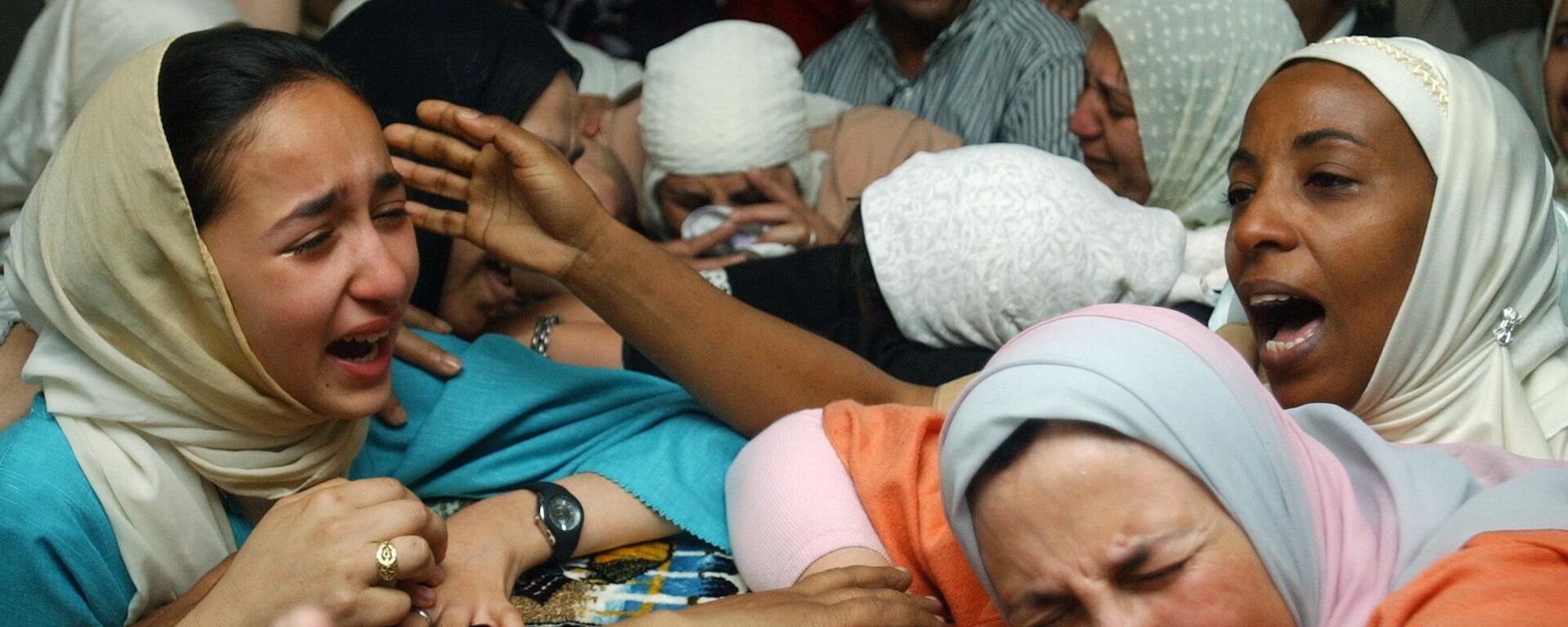https://en.sputniknews.africa/20230807/remembering-victims-of-1998-embassy-bombings-in-nairobi--dar-es-salaam-1061128116.html
Remembering Victims of 1998 Embassy Bombings in Nairobi & Dar es Salaam
Remembering Victims of 1998 Embassy Bombings in Nairobi & Dar es Salaam
Sputnik Africa
August 7, 2023 marks the 25th anniversary of the horrific terrorist attacks on the US embassies in the Kenyan capital, Nairobi, and the Tanzanian city of Dar... 07.08.2023, Sputnik Africa
2023-08-07T13:22+0200
2023-08-07T13:22+0200
2023-08-07T13:22+0200
east africa
kenya
nairobi
tanzania
dar es salaam
united states (us)
us embassy
embassy
bombings
terrorist attack
https://cdn1.img.sputniknews.africa/img/07e7/08/07/1061129302_0:164:1824:1190_1920x0_80_0_0_3efd21f28583824b05d3fbac3196534e.jpg
The bombings, carried out by al-Qaeda*, killed 224 people and injured more than 4,500 others, most of whom were local Kenyans and Tanzanians. The attacks also damaged several nearby buildings and caused widespread devastation and trauma in both nations.The bombing of the US embassy in Nairobi was the largest terrorist attack in Kenya's history. In addition, the two bombings were the first major terrorist attacks against US targets abroad since the 1993 bombing of the World Trade Center in New York.The attacks on American diplomatic missions in the two East African countries also presaged the September 11, 2001 attacks in the United States, which were also linked to al-Qaeda and its leader, Osama bin Laden. Bin Laden had issued a fatwa against the US in February 1998, declaring a "holy war" (jihad) against Americans and their allies, including civilians and military personnel.The Bombing in NairobiOn Friday, August 7, 1998, between 10:30 a.m. and 10:40 a.m. local time, a truck carrying a large bomb entered the rear parking area of the American Embassy in Nairobi.Near the ramp to the underground garage, the truck was stopped by a security guard who asked for identification and a parking permit. The driver of the truck then drew a pistol and shot the guard, while another terrorist threw a stun grenade at the embassy guard booth.The terrorists then detonated explosives inside the vehicle, causing a massive explosion that nearly destroyed the embassy and devastated the surrounding neighborhood. The explosion also damaged several nearby buildings, including a hotel, a bank, and a secretarial college.The Nairobi bomb was estimated to contain about 400 to 500 cylinders of TNT and ammonium nitrate, reportedly making it one of the largest non-nuclear explosions ever recorded.A total of 213 people were killed in the bombing, of whom 44 were American Embassy employees (12 Americans and 32 local employees). More than 4,000 people were injured, many of whom suffered from severe burns, eye injuries, and trauma.The Bombing in Dar es SalaamThe terrorist bombing at the US embassy in the Tanzanian capital took place nearly simultaneously with the truck bomb explosion in Nairobi. A truck carrying a bomb drove to the rear entrance of the embassy, where a large metal gate blocked its access. The truck was stopped by a Tanzanian security guard, who asked the driver for his identification. The driver then detonated the bomb, killing himself and the guard.The explosion created a huge crater and damaged the embassy building and several nearby structures. The blast also shattered windows and caused injuries to people within a radius of several hundred meters.A total of 11 people were killed in the bombing, seven of whom were local embassy staff (two Americans and five Tanzanian staff). More than 85 people were injured, mostly with cuts and bruises.The Aftermath of the AttacksThe bombings sparked a massive investigation by the FBI and other international players, which led to the identification, arrest, and extradition of several al-Qaeda members for their roles in the attacks. Some of them are currently serving life sentences in US prisons, while others remain at large or have been killed, including bin Laden, who was taken out by the US in May 2011. The US also launched cruise missile strikes against al-Qaeda camps in Afghanistan and Sudan a few days after the bombings.The bombings also prompted a global response of solidarity and support for the victims and their families. The US government provided humanitarian assistance and compensation to some of the survivors and bereaved. The governments of Kenya and Tanzania also offered assistance and condolences to their citizens and to the United States.In Nairobi, Dar es Salaam, and the United States, commemorative events are being held to honor the memory of those who lost their lives and to celebrate the resilience of those who survived. On the third anniversary of the attack in August 2001, a memorial park was built on the site of the former US embassy in the Kenyan capital.* Al-Qaeda is an international terrorist organization outlawed in Russia and many countries around the world.
https://en.sputniknews.africa/20230516/twenty-years-on-a-look-back-at-the-casablanca-bombings-of-2003-1059224084.html
https://en.sputniknews.africa/20230610/wanted-dead-or-alive-this-african-country-may-become-bounty-hunters-el-dorado-1059829581.html
https://en.sputniknews.africa/20230806/1061114499.html
east africa
kenya
nairobi
tanzania
dar es salaam
united states (us)
Sputnik Africa
feedback@sputniknews.com
+74956456601
MIA „Rossiya Segodnya“
2023
Muhammad Nooh Osman
https://cdn1.img.sputniknews.africa/img/07e7/04/0a/1058467512_0:0:1280:1280_100x100_80_0_0_ec723833bcbfcaed2e21952965ad99e4.jpg
Muhammad Nooh Osman
https://cdn1.img.sputniknews.africa/img/07e7/04/0a/1058467512_0:0:1280:1280_100x100_80_0_0_ec723833bcbfcaed2e21952965ad99e4.jpg
News
en_EN
Sputnik Africa
feedback@sputniknews.com
+74956456601
MIA „Rossiya Segodnya“
Sputnik Africa
feedback@sputniknews.com
+74956456601
MIA „Rossiya Segodnya“
Muhammad Nooh Osman
https://cdn1.img.sputniknews.africa/img/07e7/04/0a/1058467512_0:0:1280:1280_100x100_80_0_0_ec723833bcbfcaed2e21952965ad99e4.jpg
east africa, kenya, nairobi, tanzania, dar es salaam, united states (us), us embassy, embassy, bombings, terrorist attack, terrorism
east africa, kenya, nairobi, tanzania, dar es salaam, united states (us), us embassy, embassy, bombings, terrorist attack, terrorism
Remembering Victims of 1998 Embassy Bombings in Nairobi & Dar es Salaam
Muhammad Nooh Osman
Writer/Editor
August 7, 2023 marks the 25th anniversary of the horrific terrorist attacks on the US embassies in the Kenyan capital, Nairobi, and the Tanzanian city of Dar es Salaam in 1998.
The bombings, carried out by al-Qaeda*, killed 224 people and injured more than 4,500 others, most of whom were local Kenyans and Tanzanians. The
attacks also damaged several nearby buildings and caused widespread devastation and trauma in both nations.
The bombing of the US embassy in Nairobi was the largest terrorist attack in Kenya's history. In addition, the two bombings were the first major terrorist attacks against US targets abroad since the 1993 bombing of the World Trade Center in New York.
The attacks on American diplomatic missions in the two East African countries also presaged the September 11, 2001 attacks in the United States, which were also linked to al-Qaeda and its leader, Osama bin Laden. Bin Laden had issued a fatwa against the US in February 1998, declaring a "holy war" (
jihad) against Americans and their allies, including civilians and military personnel.
On Friday, August 7, 1998, between 10:30 a.m. and 10:40 a.m. local time, a truck carrying a large bomb entered the rear parking area of the American Embassy in Nairobi.
Near the ramp to the underground garage, the truck was stopped by a security guard who asked for identification and a parking permit. The driver of the truck then drew a pistol and shot the guard, while another terrorist threw a stun grenade at the embassy guard booth.
The terrorists then detonated explosives inside the vehicle, causing a massive explosion that nearly destroyed the embassy and devastated the surrounding neighborhood. The explosion also damaged several nearby buildings, including a hotel, a bank, and a secretarial college.
The Nairobi bomb was estimated to contain about 400 to 500 cylinders of TNT and ammonium nitrate, reportedly making it one of the largest non-nuclear explosions ever recorded.
A total of 213 people were
killed in the bombing, of whom 44 were American Embassy employees (12 Americans and 32 local employees). More than 4,000 people were injured, many of whom suffered from severe burns, eye injuries, and trauma.
The Bombing in Dar es Salaam
The terrorist bombing at the US embassy in the Tanzanian capital took place nearly simultaneously with the truck bomb explosion in Nairobi.
A truck carrying a bomb drove to the rear entrance of the embassy, where a large metal gate blocked its access. The truck was stopped by a Tanzanian security guard, who asked the driver for his identification. The driver then detonated the bomb, killing himself and the guard.
The explosion created a huge crater and damaged the embassy building and several nearby structures. The blast also shattered windows and caused injuries to people within a radius of several hundred meters.
A total of 11 people were killed in the bombing, seven of whom
were local embassy staff (two Americans and five Tanzanian staff). More than 85 people were injured, mostly with cuts and bruises.
The Aftermath of the Attacks
The bombings sparked a massive investigation by the FBI and other international players, which led to the identification, arrest, and extradition of several al-Qaeda members for their roles in the attacks.
Some of them are currently serving life sentences in US prisons, while others remain at large or have been killed, including bin Laden, who was taken out
by the US in May 2011. The US also launched cruise missile strikes against al-Qaeda camps in Afghanistan and Sudan a few days after the bombings.
The bombings also prompted a global response of solidarity and support for the victims and their families. The US government provided humanitarian assistance and compensation to some of the survivors and bereaved. The governments of Kenya and Tanzania also offered assistance and condolences to their citizens and to the United States.
In Nairobi, Dar es Salaam, and the United States, commemorative events are being held to honor the memory of those who lost their lives and to celebrate the resilience of those who survived. On the third anniversary of the attack in August 2001, a memorial park was built on the site of the former US embassy in the Kenyan capital.
* Al-Qaeda is an international terrorist organization outlawed in Russia and many countries around the world.





